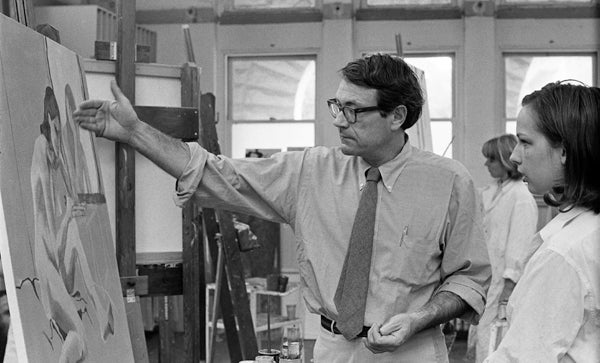|
December 20, 2013
Renowned abstract expressionist artist and former Stanford art professor dies at 92
Frank Lobdell is remembered for his commitment to his work. By Robin Wander

Frank Lobdell is remembered for the intense focus he gave to his teaching and his art. In this 1966 photo, he teaches a painting class. (Photo: Jose Mercado / Stanford News Service)
Two large paintings by Frank Lobdell hang at Stanford's Cantor Arts Center, where they command attention and demonstrate the artist's mastery of the abstract expressionist vocabulary.
Lobdell died quietly in Palo Alto on Dec. 14 at the age of 92, and the paintings, Fall 1964 (1964) and Black Edge III (1962), have become a salute to the artist and former art professor.
Recognized as one of the founders of Bay Area abstract expressionism, Lobdell is remembered on campus as an intriguing but private colleague who approached teaching and practicing art with intense focus throughout his tenure.
"Frank was an artist first, a teacher second," said Wanda Corn, Stanford art professor emerita. "He inspired students by the example he set of a fully engaged artist whose natural home was the studio and his central tool, a paint brush. And what a great painter he was; his vigorous, often rough-hewn abstractions explored every emotional chord in the human universe."
Lobdell arrived at Stanford as a visiting artist in 1965 and was invited to establish the graduate art department. He was named professor of art in 1966 and retired in 1991. During that time he attended weekly figure drawing sessions with fellow instructors Nathan Oliveira and Keith Boyle and others.
A year after retiring from Stanford, a solo exhibition of his work was mounted at the de Young Museum in San Francisco and the Cantor followed with its own presentation of his work in 1993. The curator of modern and contemporary art at the Cantor, Hilarie Faberman, is convinced that Lobdell will increasingly be more widely known and his legacy enhanced over time.
Two of Lobdell's paintings, January 1971 (1971) and Fall 1971 (1971), are part of the Anderson Collection at Stanford University that will open in 2014. The director of the collection, Jason Linetzky, says the Andersons were "inspired by Lobdell's relationship to his medium, his commitment to the vocabulary of painting and mark making, and the dual qualities of the head and the hand that they saw in his works."
Frank Irving Lobdell was born Aug. 21, 1921, in Kansas City, Mo., the son of Ruth Saxton and Earl Lobdell. He grew up in Minnesota and studied at the St. Paul School of Fine Arts in St. Paul (1939-40). Lobdell served with the U.S. Army (1942-46) in World War II, completing officer training in 1943, and arrived in Europe in 1944 shortly before D-Day. In April 1945 Lt. Lobdell witnessed the atrocities of war firsthand when his unit came upon a horrific scene in Gardelegen, Germany, where more than 1,000 concentration camp prisoners had been burned alive. This experience shaped his psyche and formed the backdrop for much of his later work. Injured in the war, he spent time in a hospital in England before returning to the United States in 1946.
After the war, Lobdell moved to Sausalito, Calif., and attended the California School of Fine Arts in San Francisco (CSFA, now San Francisco Art Institute) on the G.I. Bill (1947-50), where faculty members included Clyfford Still, Mark Rothko and David Park. At CSFA, Lobdell began a lifelong friendship with fellow painter and Stanford alumnus Richard Diebenkorn, '49.
Lobdell's war experiences made him a confirmed pacifist. At the onset of the Korean War, he left the United States for Paris, where he painted at L'Académie de la Grande Chaumière (1950-51) until returning to the Bay Area in September 1951. In 1957 he was invited to join the faculty at CSFA, where he taught until 1964.
In addition to extensive holdings at the Cantor Arts Center, Lobdell's works are in museum collections, including Albright-Knox Art Gallery, Buffalo, N.Y.; Fine Arts Museums of San Francisco; Jack S. Blanton Museum of Art, University of Texas, Austin; Los Angeles County Museum of Art; The Menil Collection, Houston; Museum of Contemporary Art, San Diego; National Academy of Design, New York; National Gallery of Art, Washington, D.C.; National Museum of American Art, Smithsonian Institution; Oakland Museum of California; Phoenix Art Museum; Portland Art Museum, Ore.; San Francisco Museum of Modern Art; San Jose Museum of Art; and UC Berkeley Art Museum.
Lobdell received many honors and awards for his work, including the Nealie Sullivan Award, San Francisco Art Association (1960); Pew Foundation Grant (1986); and Medal for Distinguished Achievement in Painting (1988) and Academy Purchase Award (1992, 1994) from the American Academy and Institute of Arts and Letters, New York. In 1998 he was elected to the National Academy of Design.
Lobdell is survived by his wife, Virginia "Jinx" Rowan Lobdell; sisters June Skjervold and Phyllis Brussel; son Frank Saxton Lobdell of Minneapolis; and son Judson (Heather) and granddaughter, Charlotte, of Tiburon, Calif. He was predeceased by his sister Doris Olson.
A memorial service is planned for early next year and a memorial exhibition will open at Hackett | Mill, San Francisco, on May 16, 2014.
-30-
|